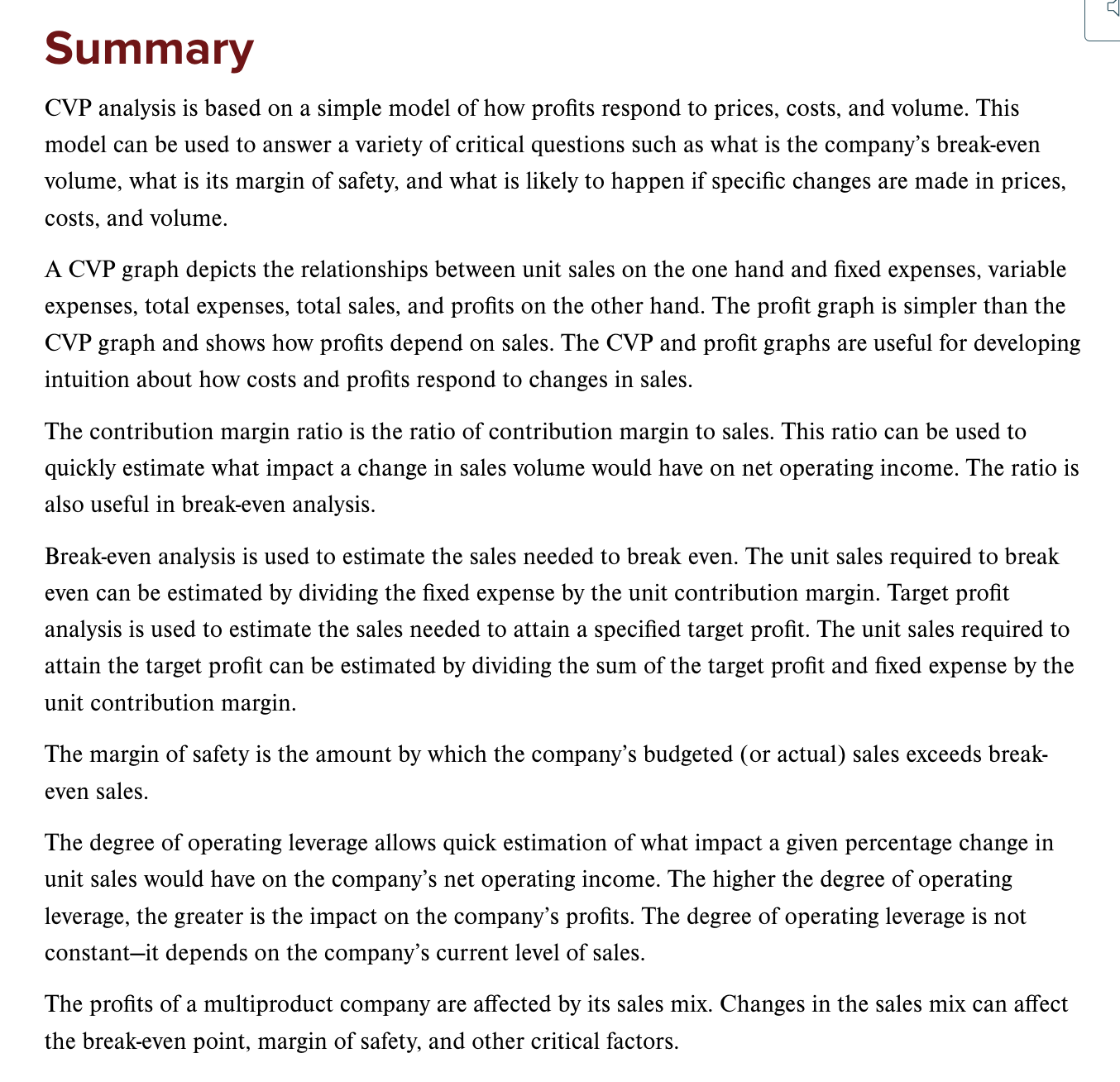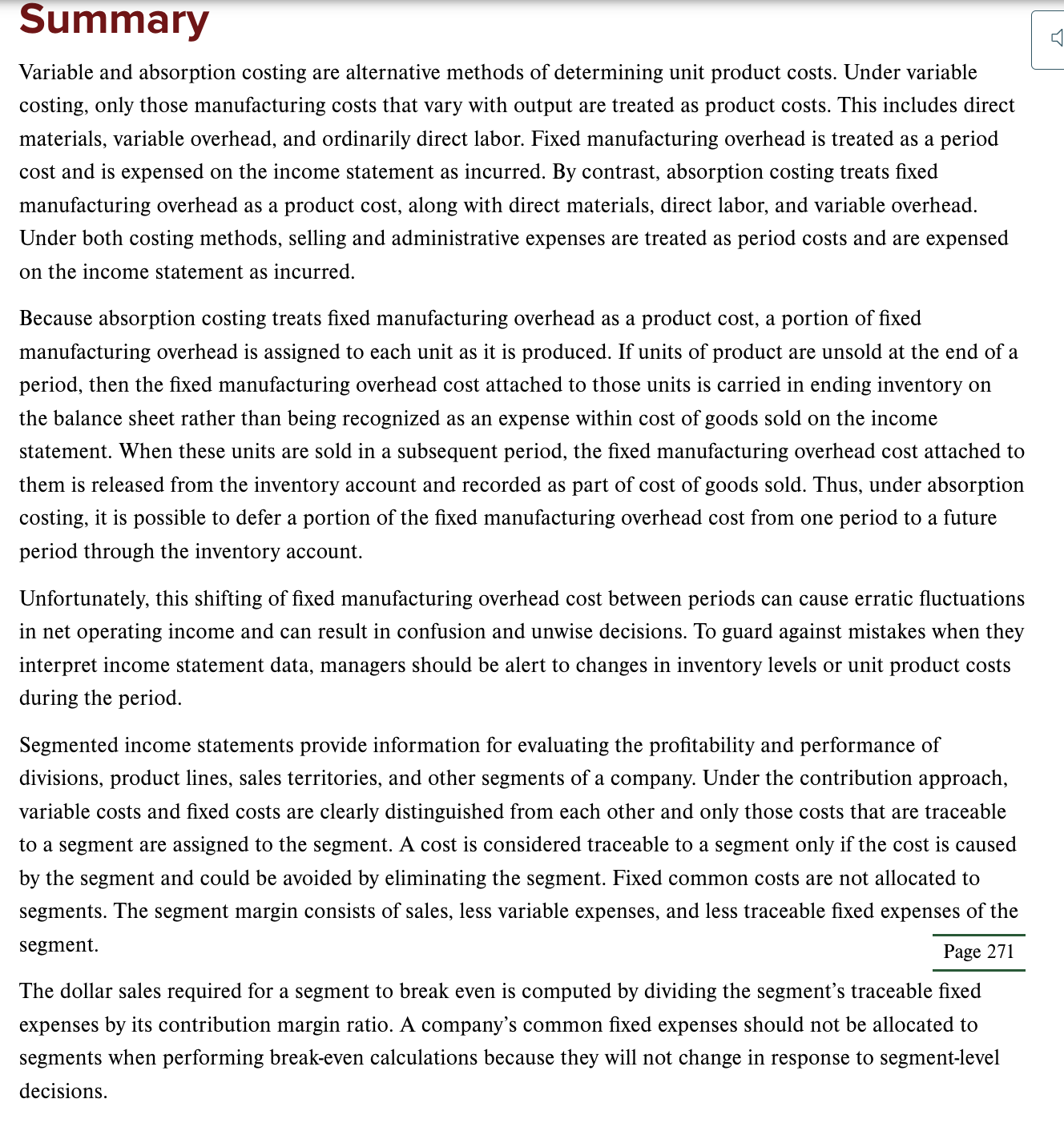Key terms
Break-even point
the level of sales at which profit is zero
Contribution margin ratio (CM ratio)
A ratio computed by dividing contribution margin by sales.
Cost-volume-profit (CVP) graph
A graphical representation of the relationships between an organization's revenues, costs, and profits on the one hand and its sales volume on the other hand.
Degree of operating leverage
A measure, at a given level of sales, of how a percentage change in salesvolume will affect profits. The degree of operating leverage is computed by dividing contribution margin by net operating income.
Incremental analysis
An analytical approach that focuses only on those costs and revenues that change as a result of a decision.
Margin of safety
The excess of budgeted or actual dollar sales over the break-even dollar sales.
Operating leverage
A measure of how sensitive net operating income is to a given percentage change in unit sales.
Sales mix
The relative proportions in which a company's products are sold. Sales mix is computed by expressing the sales of each product as a percentage of total sales.
Target profit analysis
Estimating the level of sales needed to achieve a desired target profit.
Variable expense ratio
A ratio computed by dividing variable expenses by sales.
Absorption costing
A costing method that includes all manufacturing costs—direct materials, direct labor, and both variable and fixed manufacturing overhead—in unit product costs.
Common fixed cost
A fixed cost that supports more than one business segment, but is not traceable in whole or in part to any one of the business segments.
Segment
Any part or activity of an organization about which managers seek cost, revenue, or profit data.
Segment margin
A segment's contribution margin less its traceable fixed costs. It represents the margin available after a segment has covered all of its own traceable costs.
Traceable fixed cost
A fixed cost that is incurred because of the existence of a particular business segment and that would be eliminated if the segment were eliminated.
Variable costing
A costing method that includes only variable manufacturing costs—direct materials, direct labor, and variable manufacturing overhead—in unit product costs.
Activity
An event that causes the consumption of overhead resources in an organization.
Activity-based costing (ABC)
A costing method based on activities that is designed to provide managers with cost information for strategic and other decisions that potentially affect capacity and therefore fixed as well as variable costs.
Activity-based management (ABM)
A management approach that focuses on managing activities as a way of eliminating waste and reducing delays and defects.
Activity cost pool
A "bucket" in which costs are accumulated that relate to a single activity measure in an activity-based costing system.
Activity measure
An allocation base in an activity-based costing system; ideally, a measure of the amount of activity that drives the costs in an activity cost pool.
Batch-level activities
Activities that are performed each time a batch of goods is handled or processed, regardless of how many units are in the batch. The amount of resource consumed depends on the number of batches run rather than on the number of units in the batch.
Benchmarking
A systematic approach to identifying the activities with the greatest potential for improvement.
Customer-level activities
Activities that are carried out to support customers, but that are not related to any specific product.
Duration driver
A measure of the amount of time required to perform an activity.
First-stage allocation
The process by which overhead costs are assigned to activity cost pools in an activity-based costing system.
Organization-sustaining activities
Activities that are carried out regardless of which customers are served, which products are produced, how many batches are run, or how many units are made.
Product-level activities
Activities that relate to specific products that must be carried out regardless of how many units are produced and sold or batches run.
Second-stage allocation
The process by which activity rates are used to apply costs to products and customers in activity-based costing.
Transaction driver
A simple count of the number of times an activity occurs.
Unit-level activities
Activities that are performed each time a unit is produced.
Chapter 5 summary

Chapter 6 summary

Chapter 7 summary
